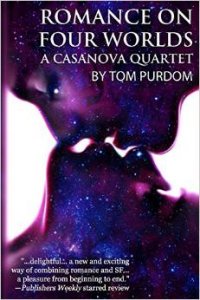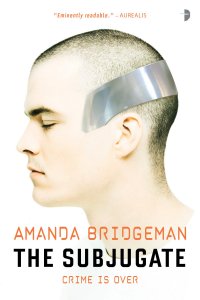Paul Di Filippo reviews Tom Purdom
Romance on Four Worlds: A Casanova Quartet, Tom Purdom (Fantastic Books 978-1627556354, $12.99, 150pp, hc) April 2015.
 For two decades now, Tom Purdom has slowly and slyly, regardless of my dim-witted inattention, been building up a series of stories centered on a fellow who might be succinctly—if reductionistically—described as an “interplanetary Casanova.” The stories all begin with the word “romance” and have all appeared in Asimov’s. This volume collects the quartet under the lovely and somewhat Vancian title Romance on Four Worlds, a title which blithely plays with the dual meanings of romance as carnal, emotional affection, a love affair, and romance as adventure, as in “scientific romances,” that great old term that predated “science fiction.”
For two decades now, Tom Purdom has slowly and slyly, regardless of my dim-witted inattention, been building up a series of stories centered on a fellow who might be succinctly—if reductionistically—described as an “interplanetary Casanova.” The stories all begin with the word “romance” and have all appeared in Asimov’s. This volume collects the quartet under the lovely and somewhat Vancian title Romance on Four Worlds, a title which blithely plays with the dual meanings of romance as carnal, emotional affection, a love affair, and romance as adventure, as in “scientific romances,” that great old term that predated “science fiction.”
Let us get acquainted first with our narrator and hero, Joseph Louis Baske. He’s relatively uncomplicated, having decided early on “to make the strange feelings a member of the other sex could evoke…the central concern of my life. I didn’t want to waste one hour of my life listening to committee reports.” When we meet him in the first tale, “Romance in Lunar G,” he is already seventy-four years old, and has used the historical Casanova and his philosophy and exploits as his template and spiritual mentor for the past twenty years.
But in this final quarter of the twenty-first century, being a septuagenarian does not mean what it once did. For medical science has brought with it longer vibrant lifespans, and various physical enhancements. (Need I mention that Baske has complete control of his amatory physiology?) More consequentially, in Baske’s estimation, science has allowed for understanding and tailoring mentalities, reining in or boosting certain baseline human impulses and brain abilities. As a connoisseur of feelings, Baske is very sensitive to modifications among his partners and interlocutors.
This whole moderately transhuman milieu of the initial adventure—to be ramped up as we progress—illustrates Purdom’s ability and desire to write the best postmodern SF that he can. While not as complex or ramified as the future imagined by Hannu Rajaniemi—nor as sometimes willfully opaque—Purdom’s future seems to foreshadow that mode: it’s not any off-the-shelf inhabited Solar System scenario, but a clever fleshing out of trends visible in our present day.
Despite the centrality of romance in his pursuits, Baske seems a proficient jack-of-all-trades when it comes to professions, with a sideline of mild espionage thrown in, just like his role model. But his fortunes have sunk to a low in the first story. Nonetheless, he has spent a lot of money to go on a lunar tourist excursion just to be next to the current woman of his fancies and fantasy, an artist named Malita Divora. Unfortunately, Malita wants nothing to do with Baske, being partnered with a politician-cum-journalist named Wen Kang. Trailing the pair to a secret assignation with a renegade secret agent, Baske finds himself fighting for his life on the harsh surface of the Moon, with his stoical sangfroid intact: “In spite of all the traditions of romantic fiction, it’s been my experience that heroic feats are an overrated form of courtship.”
The second story, “Romance in Extended Time,” occurs in 2089, and jacks up the transhumanism quotient. We are in a nanoengineered biome that encircles the planet Mercury, full of exotic humans and animals. (Cue hints of John Varley here, and perhaps even the “four worlds” title is meant to invoke Varley’s famed Eight Worlds future.) Baske has fallen in love with one Ling Chime, who is acting as secretary/bodyguard to Elector Katrinka Oldaf-Li. To be next to his reluctant inamorata, he has agreed to accompany the pair on a small journey, providing the transportation. But Baske has not realized that the powerful Yan family, opposed to the Elector’s policies, intends to sabotage her journey with everything short of fatal firepower. The resulting battle of wits fills about two-thirds of the story, leaving plenty of space for a coda involving Baske and Chime’s subsequent relationship. And auguries of further stages in human self-directed evolution come into play as well.
In “Romance with Phobic Variations,” Baske is on one of the Martian moons, in love with a woman named Nento. But it takes the intervention of a new pal, the adolescent genius named Sori, son of another woman in Baske’s life, to inform the Casanova that Nento has been deliberately remodeled just to push all of Baske’s buttons so that she can run a money-draining scam on him. Undone by his own lusts, Baske and Sori seek to scam the scammer, but run afoul of some of her tough pals.
In the final entry, “Romance for Augmented Trio,” we exist in the total post-scarcity, posthuman milieu, cleverly imagined and depicted. Baske and his latest gal pal, the superhuman Ganmei, are in a little spaceship heading for the Kuiper Belt on a multi-year journey. Out there they encounter a bad apple whom they nickname Red Boots for his Ming the Merciless-style costume. But Red Boots, thanks to his machine-intelligence linkup, proves a formidable foe, and it’s only through synergizing their talents that Ganmei and Baske escape his merciless grasp, after some suspenseful action. To praise the story properly, I’ll say that it reads like an episode of the original Star Trek as if written by John Wright.
While not exploring the matter of sexual and emotional love to the depth of a Theodore Sturgeon or a Samuel Delany, Purdom nevertheless succeeds in fashioning some farcical yet genuinely speculative and authentic romps along themes that are noticeably and regrettably absent from so much SF.







I’d say these stories are reminiscent of Cordwainer Smith and Fritz Leiber. The venerable Tom Purdom, whose writing spans from the 1950’s through today, I recommend his fiction and nonfiction from every decade for a good read.